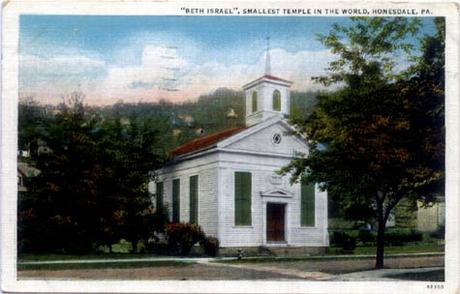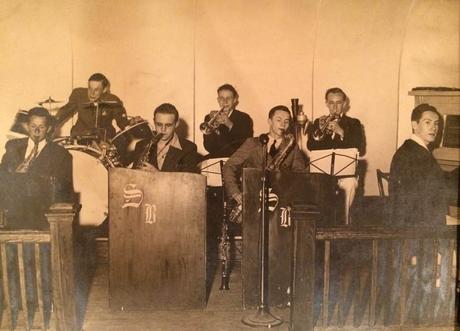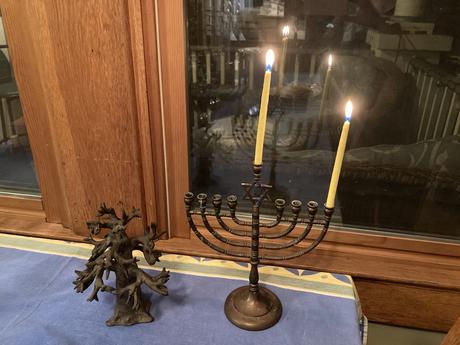 Vintage postcard depicting our temple
Vintage postcard depicting our temple On the first night of Hanukkah, I returned from my ancestral homeland, Honesdale, PA. This town, where my great-great grandparents are buried, lies in a deep valley in the foothills of the Poconos, at the confluence of the Lackawaxen River and Dyberry Creek. In Honesdale, we gather together from across the country every Thanksgiving. And on the night after Thanksgiving this year, we arrived at our teeny tiny ancestral temple for Shabbat prayers with my extended family, a mixed multitude of Jews and Christians and blood relatives and relatives-by-choice. This year, my young cousin Elizabeth led the prayers in the sanctuary where my father became a Bar Mitzvah.
Throughout our history, since my great-grandfather helped founded Beth Israel congregation in 1849, we have often led services ourselves. Some weeks, in some years, rabbis drive over from New York City to lead Shabbat for us, but my family has been leading prayers on Fridays at our temple through four generations now. This week my cousin Liza, the current president of the congregation, arrived early and lit the electric yahrzeit (memorial) lights next to the names of all our family members-including my father and my (Episcopalian) mother -lighting up half the yarhrzeit plaques in the room. Once, this temple was thought to be the smallest in the world. We are small but historic, proud and persistent-the second-oldest synagogue in the country still occupied by the original congregation.
Earlier that day, I sat in the living room of the house my grandfather built for my grandmother in 1922, and listened as my son recorded his grandfather's sister-still sharp and witty at 94-on his iPhone. Aunt Corinne told the story of the flood of 1942, when she was 14. It was a Friday night, and she went to temple with my grandparents and her little sister for the informal lay-led Shabbat prayers. Keep in mind that the temple is perched directly on the riverbank, just blocks downstream from the point where the Dyberry flows into the Lackawaxen.

Typically, in the 1930s and 40s, in winter, after 20 minutes of Shabbat prayers the whole congregation would go over to Honesdale High School for the weekly basketball game. My father's band, The Swing Seven, would play for the dance after the game. But by 1942, my father had graduated and gone off to MIT. And it was May, not basketball season, and the waters were rising, so they all hurried home after the prayers, to the house ten blocks upstream, on Dyberry Creek.
At that point my grandfather, as he had before in past floods, somehow hoisted the Steinway grand piano up onto stacks of books, hoping to keep it above the water rising from the floorboards. My grandmother and aunts retreated to the second floor. But then, my grandmother realized her children might get hungry, and went back down to the kitchen to get them some bread from the pantry. As she entered the pantry, the waters whooshed the door closed behind her, and almost trapped her. But she was a very small person (we are a family of small people) and she was able to squeeze out and slosh her way back upstairs. Late that night, the floodwaters on the Lackawaxen peaked at 50,000 cubic feet per second, killing 26 people and destroying 75 homes in Honesdale. The flood washed out every bridge in town, as well as the prized 1933 stained glass windows in the temple.
At the house of my grandparents, my aunt watched from the landing of the stairs as the grand piano rose up and turtled, floating upside down in six feet of water in the living room. The next day, from the safety of the roof, she saw a rowboat glide down her street, with a neighbor distributing bread to those trapped on rooftops. And she saw planes buzzing overhead, photographing the flood from the air.
The phone lines were out, and no one could reach my father with news they were safe. Several states away, in Cambridge, Massachusetts, an MIT classmate asked him, "Hey Katz! What's the name again of your little town in Pennsylvania again?" My father replied, "Honesdale!" And his classmate said, "Well it's flooded and it's on the front page of the paper. Look at this photo!"
When the waters subsided, and the phones finally got reconnected, my grandfather called Steinway to report four grand pianos owned by different family members in town, all submerged in the Honesdale flood. Steinway declared them beyond repair, and my grandparents began a search for a new piano. As my aunt recounted this story, sitting in the living room of her childhood home, we all looked over at the replacement Steinway. The temple made the practical decision to replace the destroyed stained glass windows with plain glass. My aunts got sent away to a relative in the countryside for weeks while my grandparents cleaned and repaired the house. And eventually two dams were built-on the Lackawaxen and the Dyberry-to prevent another deadly flood.
I realized this week, in that temple sanctuary, and in the living room of the house of my grandparents, and at the Thanksgiving meal where we entertained ourselves with a fashion parade of Katz pajamas, that we were taking risks this year. Last year, we did not gather at all. This year, we made a fraught decision to gather in spite of the pandemic, fully vaccinated and with testing and masks, because one can only go so long without family. Each year is precious, because each year we remember together the new marriages and deaths, and listen to stories from our elders, stories that may be lost.
This year, because of the alignment of the sun and moon and the secular calendar, we just missed celebrating Hanukkah together. By the time Hanukkah arrived on Sunday night, we had all gone home-to San Francisco, New York, Boston, and Washington DC. As I lit the first candle in our window, alone with my husband and our pandemic puppy, I thought about miracles.
I thought about the connections between the Hanukkah miracle of light in the darkness, of the miracle of tenacity in hostile environments, of escape from narrow places, of self-sufficiency, of adversity as the mother of innovation, of physical and emotional repair. I thought about the miracle of diversity that enriches our given and chosen interfaith families. And I thought about how objects become imbued with history, with spiritual resonance. Sometimes a Steinway is lost, and we feel desperate to replace it. Sometimes stained glass windows are lost, and plain glass just makes more sense. Sometimes a temple is ransacked, and all it takes is a little oil to persist with rituals that heal and bind.
I have trouble letting go of the stories from each generation, the objects left behind. And that is how I found myself yesterday driving away from Honesdale, over the mountains, in a car filled with a rotary telephone, a hatbox, vintage Pyrex, embroidered linens, and photographs, desperate to preserve family history from the floodwaters of time. Inevitably I know that some precious objects, and some stories, will be lost, and some will be passed down. And I feel a sense of gratitude that my son wanted both my aunt's words recorded on his iPhone, and that rusted enamel colander with the missing handle.


